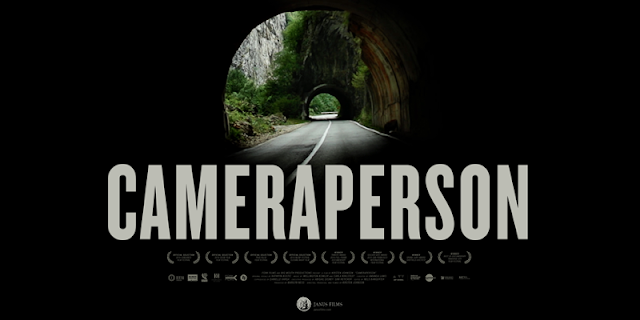Tuesday, September 5, 2017
Cameraperson
Cameraperson is a memoir film from documentary cinematographer Kirsten Johnson. She took moments from throughout her 25 years behind the camera for other people's films and created this movie that summarizes her experience, using her visual perspective to talk about who she is and how she sees life. Rather than a linear storyline, the film organizes scenes around themes that express the range of joy and pain unique to her job and life. Just as a camerperson can choose exactly where to focus on an image to say something without words, Cameraperson uses a lifetime of filming to say something unique and beautiful without having to actually say anything at all.
Like so many of the best documentaries, this is a personal film. What makes this unique is that Johnson has these vignettes recorded from throughout her career where she is focusing on something outside of herself that when you pull together, using specific pieces, tell a lot about who she is. Johnson uses her own natural visual eye - always through her camera - to tell the story on its own without any direct narrative or description. She had originally created a more direct cut with voiceovers, focusing on the most traumatic and moving things she's captured. Eventually, though, Johnson and her team relied on the visuals to speak for themselves, using shots and scenes, juxtaposed in meaningful ways, to create a deeper meaning than you could ever really explain using words. More importantly is how the little bits they choose to use key into who she is without showing her at all.
Nels Bangerter, Editor for Cameraperson, was tasked with starting the process anew a few years into the project by taking several disk drives' worth of video and paring it down to tell a story. Rather than show some of the most objectively significant or traumatic things she'd shot, he focused specifically on the moments where we are aware of her presence, though rarely when we see her onscreen. Normally, a camerperson's directive is to go unnoticed, allowing the subject to be the focus rather than the person behind the camera. He said, "We began to realize that these tiny moments on the edges of other films is where her presence comes from...In essence we were making a very thoughtful, emotional, and revealing outtake reel." The mechanism by which this is done is often simple yet ingenious, like the short montage of many quick moments of Johnson walking with a camera, often backwards, and attempting to follow one or more subjects. Or a supercut of the moments where people realize they're being filmed. The observations are often weightier and become more personal as the movie progresses, her mother's experience with Alzheimer's and then eventual death playing a big role.
Using the visuals to tell the story leaves a bit more mystery in the film and allows us as the audience to arrive at conclusions on our own. At times Johnson uses the voices of her own subjects to comment on and share her feelings. For example, during a heart-wrenching scene in a Nigerian hospital we spend a few minutes watching a midwife work with a baby struggling to breathe. We then cut to an entirely separate sequence, distinct in date and time, of a man reflecting on having relived an intense moment of his past. He comments on how he can feel that emotion again so readily when he's not expecting it. While this is interesting, it becomes clear why we're watching it when we jump directly back to the hospital in Nigeria. Johnson is using his words to express how she feels watching and thinking about that baby and that hospital. And then, in the more meta context of Cameraperson, how these stories and experiences affect her life and stick with her. By showing us these principles, rather than telling us, we feel what she feels more readily just as we see what she sees through the camera. It's a brilliant way to communicate, even more so because when we as the audience make the realization on our own we may even jump to our own personal experiences and connect the idea directly to our own reality. And that's how storytelling like this can make an impact.
Subscribe to:
Post Comments (Atom)

No comments:
Post a Comment